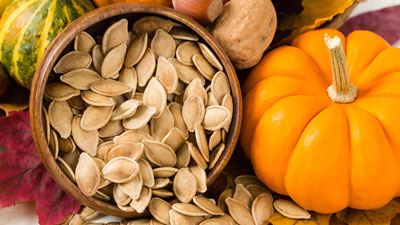
We eat a lot of seeds, but not all are categorized as such. Some are nuts, some are legumes, and some are even categorized as whole grains like quinoa, millet or dried corn! But then, we have the ones that we simply refer to as seeds. Some of them come from squash or pumpkins while others come from pods. And some come from giant flowers while others come from tiny flowers.
Nutritionally speaking, they can vary quite a bit too. For example, chia and sesame seeds are great sources of calcium, sunflower seeds are very rich in vitamin E, pumpkin seeds are high in zinc, and chia and flaxseeds are incredibly rich in omega-3 fatty acids.
On his Daily Dozen, Dr. Greger recommends that we eat 1/4 cup of nuts or seeds every day. Keep it interesting by switching them up. Different varieties can make great additions to soups and salads, fantastic snacks on trail mixes, creamy spreads and butters, or delicious treats like chia pudding.
When we eat a variety of foods, we get a variety of nutrients, including a variety of fibers for our diverse microbiome. Just be mindful not to exceed the recommended daily amount because they are very rich in fat. This means that they can lead to weight gain or keep us from losing weight, if that’s what we’re trying to do.
Click on the pages below to learn more details. Subscribe to our newsletter and be the first to know about our latest content additions!
Interactive Pages
Visit our first nuts interactive pages and learn about their nutritional values, how they can support our health, and tips to enjoy them!
Related Instagram Content




